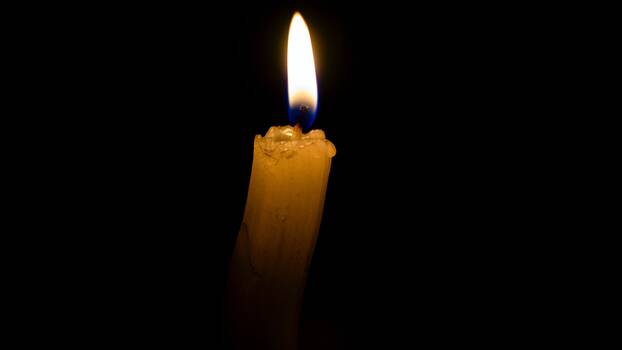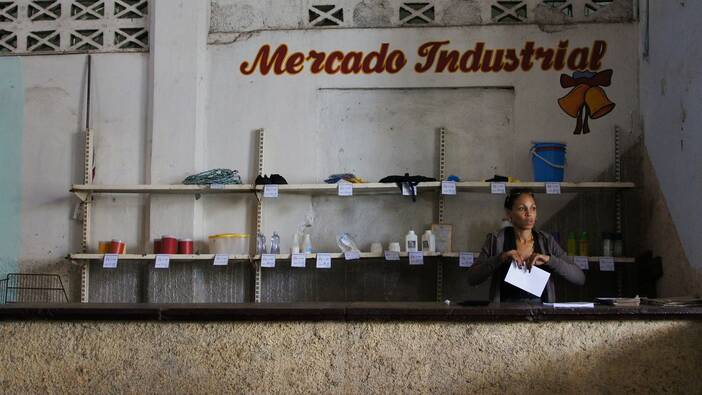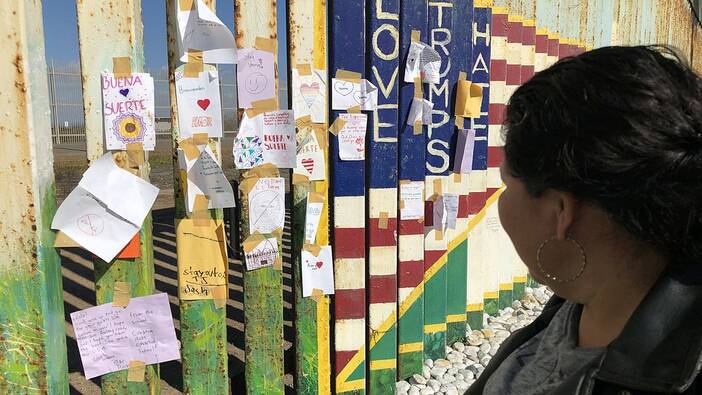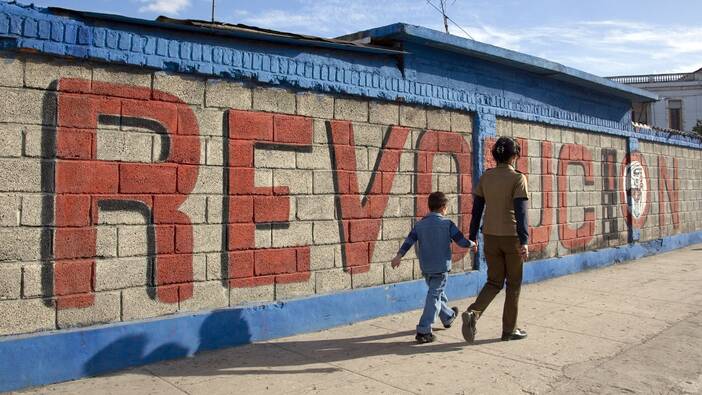It’s 18:55 in Santiago de Cuba, in the southwest of the island. A group of children kicks a ball in the middle of Calle Carnicería. Football has become a popular sport in the land of baseball in recent years. It’s Friday night, and the street is crowded, like all the streets in the city.
Federico Mastrogiovanni is an Italian journalist who has lived in Mexico since 2009. He was honoured with the Mexican PEN Association award for his book Ni vivos ni muertos (Penguin Random House, 2016).
Translated by Joseph Keady and Michael Dorrity for Gegensatz Translation Collective.
Suddenly, the lights go out and the scene is plunged into a thick, total darkness. The blackout has started.
Lamps with rechargeable batteries turn on in the windows one by one, giving off a cold, white light. But the people in the street don’t seem particularly bothered. On one corner, a few teenagers keep listening to reggaeton music, dancing and laughing, sporadically illuminated by the lights of the few cars that pass by.
From now until the morning, this part of the city will have to stay in the dark while adjacent neighbourhoods have light. This alternation of light and dark zones has been the solution for coping with the systemic shortage of electrical power in Santiago de Cuba and across the island in general.
Planning Accordingly
In Santiago de Cuba, the electricity runs in six-hour intervals during the day and four hours at night and in the early morning in order to minimize the impact.
The way that people deal with it varies by location. In many workplaces, such as at the Universidad de Oriente in Santiago de Cuba, staff organize to finish their work by shortly after noon. They then either leave or, depending on whether electricity is secured for the afternoon, begin working after lunch. When everything goes according to what the authorities planned and announced, one day they will have power in the morning and the next in the evening, and plan accordingly.
Stores, ATMs, streetlights, private homes, and public buildings — everything comes to a halt in the same way. People have learned how to tell when a blackout is coming. They’ve learned to prepare for it, at least in an organizational sense, with a degree of dissatisfaction, frustration, and growing social unease. But the people have also learned to live with blackouts, circumvent them, try to escape them or, to the extent possible, sidestep the hit that paralyzes their lives and impacts their everyday activities.
The state sells energy at a price that is lower than the production cost in order to guarantee that people have access to it.
The generation of Cubans born after 1995 did not live through the serious hardships of what is known as the “special period”, and therefore had not experienced blackouts until the summer of 2021. The special period was marked by a deep recession and overlapped with the collapse of the socialist bloc in Eastern Europe. Once Cuba was able to overcome it, it managed to improve its electrical production capacity with a fossil fuel plan based on investments and credit extensions.
The two ways that electricity is produced in Cuba are thermoelectric plants, which burn fossil fuels and generate steam that moves a turbine, and what is known as distributed generation, an archipelago of sites that produce electricity through units that generate power by burning either diesel fuel or gasoline — a resource that is not available in large quantities in Cuba.
Energy production in Cuba has been streamlined over the years. The electrical plants, many of which are 60 years old and highly obsolete, were updated. That process peaked around 2005 and 2006, and Cuba has not altered its power plants since then.
The island has gambled for years on lowering the cost of generating electricity by using domestic fuel, or crude oil that it extracts within the country or in its own territorial waters. There is not much of it, but according to official statistics it is enough to meet demand. Nonetheless, the chemical makeup of Cuba’s domestic fuel is very hard on the country’s power plants. It is considered to be very heavy with a high percentage of sulphur, which causes dirt to build up in the boilers. The low quality of Cuban crude oil causes significant wear and shortens the life of the production plants.
In the second half of 2021, after more than 15 years of wear and tear with no chance to radically transform the electrical power production system, several thermoelectric plants were simultaneously removed from the grid.
Searching for Alternatives
Enrique Estrada Pato is a mathematician and a professor at the Universidad de Oriente, where he teaches mathematical analysis and algebra. Since the blackouts started in 2021, he has continuously collected information, cross-referenced data, and examined the country’s capacity to generate electricity, and is now an expert on the subject. During our interview, a blackout struck the entire area of the city where Professor Estrada was.
For months, I’ve been cross-referencing all the data that has been coming out, analysing it, systematizing it, and making calculations based on it. Math is my job. Cuba’s energy mix, with its roughly 20 blocks of thermal generation, plus all the plants that are distributed across the island, produces a bit more than 2,000 megawatts per day. At peak moments during the year, demand exceeds generation capacity by about 100 megawatts on average. If we assume that all the thermal generation units are fully functional in the national grid at the same time, they still don’t meet demand, and that’s why we have the other energy source: distributed generation.
Nights are warm almost year-round in Cuba, and the lack of electricity means that people cannot use their fans. It becomes impossible to get enough rest in a country where the temperature can easily exceed 30° C.
Starting in mid-2021, there have been power outages ranging from six to 12 hours or more during the day, depending on the province. The City of Havana has special protection due to its status as the capital. It suffers less from energy cuts, which do not exceed four hours, one or two days per week.
The whole month of December 2022 passed without serious problems.
The situation is more difficult in the rest of the country. In some provinces, as much as 90 percent of the demand capacity has been impacted, leaving them with scarcely 10 percent power — meaning that entire provinces are turned off. There have been moments when civil unrest has increased significantly, to the point that riots and public demonstrations have broken out with large numbers of people participating — with temperatures so high, even something as simple as resting becomes unbearable.
Investments have been made in the midst of the difficulties. Cuba has a distorted, fossil fuel-based energy mix with a commitment to renewable energy production, but that still is not nearly enough, as it hardly meets 2 percent of the country’s demand.
The cost of generating one kilowatt in Cuba is among the highest in the region, and the population pays a rate that is, in fact, below the actual cost of producing it. In other words, the state sells energy at a price that is lower than the production cost in order to guarantee that people have access to it.
The state power company, Unión Eléctrica de Cuba, shares information every day via Telegram and other social media as well as television in order to inform the public about the blackouts and to transmit its forecast for the day. That prognosis is often incorrect, because there are many variables at play.
Professor Estrada concludes:
They are trying to recover the cost, and to reduce — not resolve — to reduce the impact. And that means less time with power outages, because the problem can’t be solved in the really short term. Even if all the units were connected, they wouldn’t meet the demand. It’s a slow, expensive process, it has to make up for 15 years of wear and tear. Sometimes you have the technology, but you don’t have the fuel, because it’s expensive, you have to import it, and the blockade stops a lot of ships, because the shipping companies that bring fuel to Cuba are also persecuted. A ship that lands on the coast of Cuba is banned from US ports for six months.
For years, Cuba has had a fuel import agreement with Venezuela, which has not been able to maintain the consistent volume it did in the past due to its persecution by the US. Russia has also been an active supplier. In recent months, information has spread about Russian cargo ships transporting fuel, including fuel used in the patanas, or floating power plants that generate power in Havana Harbour and Mariel. One thing that led to Cuban President Díaz-Canel’s recent turn toward Turkey, Russia, China, and Algeria was precisely the possibility that Algeria could become a new fuel exporter.
Blackouts Won’t Stop Us
The whole month of December 2022 passed without serious problems. Now it is 16:21 on 23 January in Santiago de Cuba. The group Folkloyuma is playing its repertoire of Afro-Cuban folk music on the Patio de la Jutía Conga at the Unión Nacional de Escritores y Artistas de Cuba (UNEAC) as part of the Festival Internacional Jazz Plaza, one of Cuba’s most important and beloved musical events.
Suddenly, the microphones go out and we hear their voices as we would have to hear them in the countryside. The musicians keep playing congas and Cuban claves, the women keep singing to the rhythm of the drums, and the men dance, but something has changed. The electricity is gone.
The blackout has started.
The sunlight diminishes little by little and the exhibitions on the programme are at risk. It looks like the blackout will ruin the Santiago night, but something else happens — something particularly Cuban.
A man in the audience stands up, steps in front of the stage, and starts to sing a bolero a cappella. His silhouette is still visible, but it is difficult to make out his features now. People listen in silence. Applause breaks out when he is finished. A mere blackout cannot stop Cubans’ love of music and art. After the bolero, various audience members take turns singing or reciting poems.
A young woman from the US gets on stage speaking uncertain Spanish. She is accompanied by a Cuban man with a contrabass. People mumble their mistrust for the young blonde-haired woman, but they give her a chance. We are in total silence and darkness. The woman is illuminated only by a few cell phones. She sings “La vie en rose” and definitively conquers the audience. It’s a hit. The venue managers are moved as they make their way toward the stage.
“It’s just so lovely. That’s pure jazz.”



